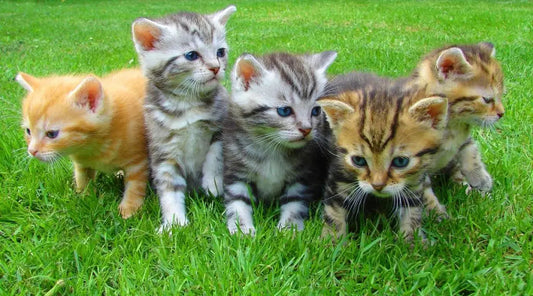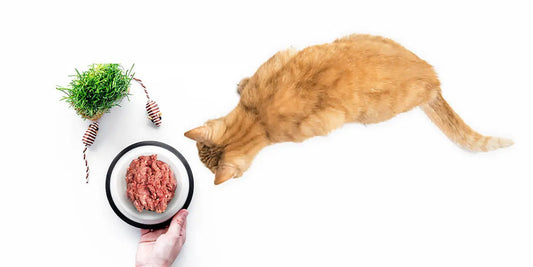
How to Keep Your Cat Hydrated and Encourage Drinking Water
Like humans and their fellow four-legged friends, cats need to maintain proper hydration to stay healthy. But what does healthy hydration actually look like for cats?
In this guide, we’re answering a complex question: “How do I get my cat to drink more water?” Below, we’ll help you understand your cat’s water needs, identify signs of dehydration, and use clever tips and solutions to make sure your cat is drinking enough.
Whether your cat is already struggling with hydration or you’re doing your homework before bringing home a new feline friend, the tips below will help you make the best possible decisions for your cat’s health.
Understanding Your Cat’s Water Needs
Before we dive into our main topic—how to keep cat hydrated—let’s touch on some hydration basics. Even if you’re already a pet health guru providing fresh cat food instead of kibble, offering tons of enrichment, and scheduling regular vet visits for your cat, proper hydration is the foundation for overall health.
How Much Water Do Cats Need?
There are two key factors to consider when discussing how much water cats need:
-
Hydration needs vary – The amount of water your cats need will depend on factors from their activity level to the average temperature of their environment.
-
Food matters – All cat food has some water content—even dry foods are 3 to 11% water by weight. If your pet already eats canned or raw cat food, they may be satisfying most of their water needs during meals.
These factors explain why veterinarians recommend a range for hydration instead of an exact figure: approximately 44 to 66 milliliters (mL) of water per kilogram (kg) of body weight.
Here’s a chart with various weights and recommended hydration ranges based on the above values (in metric and imperial units):
|
Weight (kg) |
Weight (lb) |
Water Volume (mL) |
Water Volume (cups) |
|
3 kg |
7 lb |
132 - 198 mL |
0.5 - 0.8 cups |
|
4 kg |
9 lb |
176 - 264 mL |
0.7 - 1.0 cups |
|
5 kg |
11 lb |
220 - 330 mL |
0.9 - 1.4 cups |
|
6 kg |
13 lb |
264 - 396 mL |
1.1 - 1.7 cups |
|
7 kg |
15 lb |
308 - 462 mL |
1.3 - 2.0 cups |
The most important thing to note is that water needs increase with weight—the more your cat weighs, the more water they’ll need to stay hydrated. Your cat’s water needs may also increase if:
-
You live in a warm climate (or you’re in the middle of a hot summer)
-
Your cat is recovering from an illness
-
Your cat is highly active or gets a lot of exercise
Common Causes of Dehydration in Cats
Dehydration in cats can occur for several reasons, and identifying the cause early can help prevent complications. Some common factors include:
-
Limited access to water – If a cat’s water bowl is empty, dirty, or located in an inconvenient spot, they may not drink enough.
-
Illness or medical conditions – Certain diseases, like kidney disease or diabetes, can increase the risk of dehydration. If your cat is drinking less than usual, consult a veterinarian.
-
Hot temperatures – In warm weather, cats lose more fluids through panting and may need extra fresh water to stay cool.
-
Dietary factors – Dry food diets lack the moisture cats naturally get from their prey, increasing their reliance on drinking water. If you’re wondering, can cats eat dog food, the answer is no—dog food lacks the essential nutrients and moisture cats need, which could lead to dehydration.
-
Stress or anxiety – A stressed kitty may avoid their water source, especially if their bowl is in a high-traffic area or near another animal.
Recognizing these signs of dehydration early can help you take the right steps to encourage proper hydration.
What Happens If Cats Don’t Drink Enough Water?
If cats don’t eat enough to sustain their body weight, they’ll lose weight. But what happens when cats don’t drink enough water?
In the face of dehydration, cats may develop:
-
GI issues – Water is a building block of healthy digestion. Without enough water, your cat may struggle to properly digest food and develop GI problems.
-
Respiratory challenges – Without enough water, cats may become out of breath more quickly during exercise.
-
Urinary tract problems – Proper hydration supports healthy urination—you may notice your cat using the litter box less frequently if they aren’t drinking enough water.
Signs of Cat Dehydration
What about other potential signs of cat dehydration? Watch for symptoms like:
-
Poor skin elasticity – Your cat’s skin should snap back into place quickly after moving. You can test their skin elasticity by pulling up on the flap of skin between their shoulder blades; if it falls back into position quickly, your cat’s skin elasticity is normal. If it takes a while to settle, your cat may be dehydrated.
-
Gum and tongue issues – If your cat’s tongue and gums are pale or their saliva is stickier and tackier than usual, they may not be getting enough water. Tacky saliva may also interfere with their normal eating habits, so watch for behavioral changes at meal times.
-
Sunken eyes – Unfortunately, sunken eyes can be a sign of multiple potential health issues in cats. However, dehydration is one of the most common causes of sunken eyes.
-
Low energy – If your cat is usually outgoing, energetic, and quick to play with toys, dehydration could decrease their overall activity level. If your cat is relatively low-energy normally, this may make dehydration more difficult to spot.
Tips to Encourage Your Cat to Drink More Water
If you believe your cat may be dehydrated, we can help. The tips below can encourage your cat to drink more water and improve their overall hydration long-term.
Choose the Right Water Bowl
Take a look at your cat’s water bowl. The water inside should be:
-
Clean – If dust has settled on the surface of the water or dirt has collected at the bottom of the bowl, your cat may be less likely to imbibe.
-
Fresh – If you have a large water bowl, you may be less likely to change the water often. Even if the water doesn’t look dirty or dusty, replacing the water frequently may make it more appealing for your cat.
What does this have to do with water bowl choice? With the right bowl, you can more easily and consistently monitor your cat’s water supply.
-
Choose a light-colored bowl – A dark-colored water bowl may hide dirt and dust in the water. Instead, opt for a light-colored dish to provide a stark backdrop, making it easier to see any contaminants.
-
Opt for a small bowl – Your cat’s water should be changed frequently—every day or every other day at minimum. By opting for a smaller bowl, you can discard any excess water while limiting waste.
-
Seek a bowl with measuring marks – If you suspect your cat is dehydrated, choose a bowl with volume measurements; you can use these to track your cat’s approximate water intake each day (information that can help you and your vet).
Place Water Strategically
While they certainly have differences, dogs and cats have similar needs—like proper hydration.
When trying to get dogs to drink more water, pet parents are often encouraged to adjust their water bowl placement. Putting a water bowl right next to the dog door, the food dish, or their bed might make dogs more likely to make a pit stop on their way to their next activity.
The same is true for cats. To encourage your cat to drink more water, consider placing their bowl:
-
Close to their favorite perch or cat tree
-
On their way to the litter box
-
Next to their food bowl
-
Next to the place where you often give them treats
Don’t be afraid to experiment—try a few different locations or place multiple water sources around your home and observe your cat’s response.
Try Flavored Water Enhancements
If switching bowls, changing the water more often, and changing the bowl location still haven’t encouraged your cat to drink more, consider enhancing their water with natural flavors.
For example:
-
Leftover liquid from a canned or raw cat food container
-
A few drops of liquid from a tuna can (tuna soaked in water, not oil)
-
Spoonfuls of (homemade) liquid broth
However, if you take this route, keep in mind that you may need to change your cat’s water even more frequently to prevent spoilage and bacterial growth.
Innovative Hydration Solutions
While the tactics above may help you combat dehydration in the short term, there are a few additional steps you can take to encourage long-term healthy hydration for your cat. Let’s explore two potential options for cat parents.
Cat Water Fountains
Vets have discovered that cats may drink more water if they have access to a constantly-flowing water source—like a cat water fountain. If you decide to try a cat water fountain, remember to:
-
Clean the fountain regularly – Circulating water fountains will feature nooks and crannies where dirt can settle—and grow bacteria. Clean your cat’s fountain regularly according to your vet’s recommendations.
-
Change the filter – Many cat water fountains feature filters; these will need to be changed according to the manufacturer’s instructions. Consider stocking up on filters so you always have a few extras.
-
Practice safe plug-ins – Most cat water fountains will require a power source. To prevent electrical issues, plug devices directly into GFCI outlets and keep your fountain as far from other electrical devices as possible in case of water splashing.
Wet Food Diets
When cats and dogs aren’t eating enough or drinking enough water, vets often recommend changes to their food—switching from dry to wet food, for instance.
For example, if you’re worried why “my cat won’t eat,” switching to wet food can help. Wet and raw foods feature more water content than kibble; some wet foods feature up to 80% water content. So, switching to wet or raw food could offer a simple way to introduce more water into your cat’s diet.
Plus, pet food delivery options are making it easier for cats to get the nutrients they need, regardless of whether they eat wet or raw food.
Encourage Healthy Hydration with Darwin’s Natural Pet Products
Cats, like other pets, need plenty of water to thrive. But if you’re struggling to keep your cat hydrated, consider switching to a high-quality, raw pet food.
Darwin’s Natural Pet Products is your source for fresh, raw pet food shipped right to your door. Our true raw pet foods are designed to meet your cat’s ancestral needs; minimally processed, fresh, raw food is the closest thing your pet can get to the food they were designed to eat.
Ready to make the switch? Support your cat’s health with Darwin’s cat foods now.
Sources:
- Merck Manual. Nutritional Requirements of Small Animals. https://www.merckvetmanual.com/management-and-nutrition/nutrition-small-animals/nutritional-requirements-of-small-animals#Energy_v3328508
- Boston Veterinary Clinic. Here’s How to Tell If Your Cat is Dehydrated and How to Help. https://www.bostonveterinary.com/web-tails/cat-dehydration/
- FEDIAF. The Importance of Water in Your Pet’s Diet. https://europeanpetfood.org/pet-food-facts/fact-sheets/nutrition/the-importance-of-water-in-your-pets-diet/
- Consumer Product Safety Commission. What Is a GFCI?. https://www.cpsc.gov/s3fs-public/099_0.pdf
- UC Davis Veterinary Medicine. Cat Health. https://ccah.vetmed.ucdavis.edu/cats/cat-health


